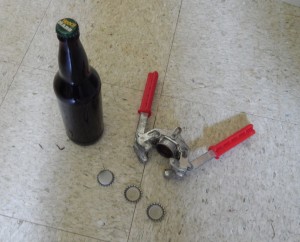 I was sidelined from brewing earlier this year, due to an injury. Now I’ve recovered, and it’s time to get back in the saddle again. I’ve got a couple brewing sessions planned in the coming days, but first I wanted to clear some fermenter space. And so I bottled my porter, a cherry mead, and a berry wine.
I was sidelined from brewing earlier this year, due to an injury. Now I’ve recovered, and it’s time to get back in the saddle again. I’ve got a couple brewing sessions planned in the coming days, but first I wanted to clear some fermenter space. And so I bottled my porter, a cherry mead, and a berry wine.
Porter
The porter was my usual Colby House Porter. It was a 3.0-gallon (11-L) batch, so I decided to put it in 22-ounce (650 mL) bottles rather than kegging it. From a preliminary sample, I wasn’t sure if it was as hoppy as I like it. I also wondered if it turned out too dry this time around. Then again, the sample was warm and flat and I’ve learned not to start dissecting a beer until it’s carbonated and conditioned. I’ll let it bottle condition for a couple weeks before cracking one open.
Mead
The mead was my Erik the Red recipe that I featured in my “Dive into Mead Making” article. The color was dark purple, and it was still a bit murky when I bottled it. I probably should have let it sit longer before bottling it, but it won’t hurt if a little sediment falls out in the bottles. The cherries smelled very good, as did the honey, even though I used a fairly inexpensive clover honey. The mead was lightly sweet, and — at an estimated 12% ABV — tasted strong, but not “hot.” It showed good “legs” in the glass.
As it is, I would rate this mead as fair. However, I think it will fairly quickly age into something considerably better. In retrospect, I should have racked it one more time before bottling. But, I was too focused on freeing up the fermenters. Live and learn.
Wine
Oddly enough, the wine – the beverage with which I have the least experience — was in the best shape when I bottled it. It was light red, crystal clear, and tasted and smelled strongly of fresh, ripe fruit. I used quite a lot of high-acid fruits in the wine, and it was very definitely “zingy,” although not full on tart or sour. Although it was fruity, it had enough “structure” — from the grapes and added grape tannin — that it wasn’t like alcoholic Kool-Aid. I decided to add some sugar and let it carbonate into a sparkling wine. It should make a nice summer wine.
Brewing Plans
In January, I made big plans to brew a bunch this year. I’m obviously behind schedule, but I’m going to follow my original plan fairly closely. I am going to make a session beer (my Copper Clipper) first, just to replenish my homebrew supplies, but then I’m going to brew my Patrick Henry Pale Ale and Beelzeboss as planned. I want to get started on another gueuze project, but also try out my imperial tripel idea — using reiterated mashing — as I planned, so that’s up after the first three or four brews. And somewhere, I need to squeeze in a brew day for my Exercise Recovery Ale. I hope to get those six batches knocked out as quickly as possible, then proceed with the 2014 plan at a more leisurely pace.
It’s going to be hotter than hell all summer here in Texas, so I plan to brew all of these beers as 3.0-gallon, all-grain brews. That way, I can brew indoors where it’s air conditioned. I’ll fire up the big brewing rig again in the late fall, when temperatures drop. (I’ll get enough of the summer heat working in my garden.)
—
Related articles

Hey Chris,
Were you able to actually find grape tannin, or was it just labeled wine tannin? Most of the wine tannin formulations out there are made from one or more varieties of oak heartwood, not grape skin. I was looking to replace the tannins lost from not having grape skins with my kit, but I already plan on adding some oak chips to the secondary too, so I felt it was redundant adding more oak tannin.
– Dennis, Life Fermented Blog
It was probably just wine tannin. I’d have to check the package.